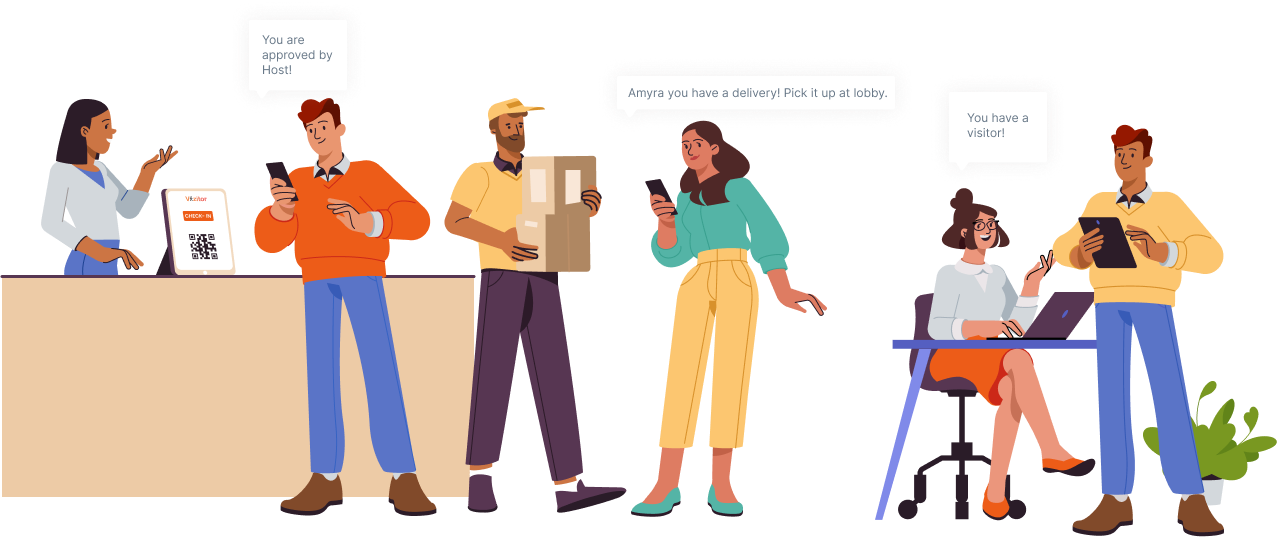Table of Content
Try Vizitor for Free!

Tue, Mar 28, 2023
Read in 7 minutes
In modern times,technology and digitization is creating enormous opportunities for businesses. Technology can help businesses to reduce costs by automating processes, improving efficiency, and reducing waste. This can help businesses to increase profitability and reinvest in growth initiatives.
By leveraging technology effectively, businesses can gain a competitive edge over their rivals. Digitization allows businesses to automate and streamline many processes, reducing the time and effort required to complete tasks.
Employees are a valuable asset to businesses, and their skills, knowledge, and experience are critical for achieving business goals and objectives. It is important for businesses to invest in their employees’ development and well-being to foster a positive and productive work environment.
Understanding the ‘Human Side of Digital’ is critical in today’s modern era.
Also, Digitization has a significant impact on employees. Digitization enables remote work and flexible work arrangements, giving employees more control over their work schedules and allowing them to better balance their work and personal lives.
Enterprises that interpret the human side of digital create safer environments providing numerous opportunities to employees thus balancing their well-being also.
In this article, we’ll understand the benefits and impact of digitization on employees and how to balance automation with employee productivity.
Automation and employee well-being
From automating routine tasks to providing valuable insights into employee performance, digitization is revolutionizing the way we work and learn. Automation is fundamental and its capabilities have increased exponentially in recent years. But it’s not just businesses that benefit from automation; employees do as well.
Automation helps employees to be more efficient in their tasks, which can lead to increased productivity. Automation can take over dangerous tasks, reducing the risk of injury or harm to employees. Automation can create opportunities for employees to learn new skills and take on more complex tasks, which can improve their job satisfaction and career prospects.

The human side of digitization
The human side of digitization refers to the impact that digital technologies and processes have on people, both in their personal lives and in the workplace. While digitization has brought many benefits, such as increased efficiency and access to information, it has also had significant implications for people’s lives and well-being.
Here are some of the ways in which digitization has affected the human side of work and life:
1. Changing job requirements:
Digitization has led to the creation of new jobs and the elimination of others. It has also changed the skill requirements for many jobs, making it necessary for workers to continuously learn and adapt to new technologies and processes.
2. Increased flexibility:
Digital technologies have made it possible for people to work remotely and to have more control over their work schedules. This has allowed many people to achieve a better work-life balance.
3. Social isolation:
Digital technologies have made it easier to connect with others, but they have also contributed to increased social isolation. For example, people may spend more time interacting with screens than with other people, leading to feelings of loneliness and disconnection.
4. Increased surveillance:
Digital technologies have made it easier for employers to monitor their employees’ activities, which can contribute to feelings of distrust and anxiety.
Digitization has had a significant impact on the human side of work and life. It has brought many benefits, but it has also created new challenges that must be addressed to ensure that people can thrive in the digital age.
Balancing automation and emplpyees experience is crucial
Balancing automation and employee experience is crucial in the modern workplace. While automation can bring many benefits, such as increased efficiency and productivity, it can also have negative impacts on employees’ job satisfaction, well-being, and career prospects. Therefore, it is essential to find a balance between automation and employee experience to ensure that workers are adequately supported and engaged.
.png)
Here are some of the reasons why balancing automation and employee experience is important:
1. Employee engagement:
High levels of employee engagement are crucial for business success. If employees feel that their skills and contributions are valued, they are more likely to be productive, creative, and committed to their work. Balancing automation with employee experience can help to ensure that employees feel engaged and motivated.
2. Retention:
In today’s competitive job market, retaining talented employees is more important than ever. If employees feel that their jobs are at risk due to automation, they may be more likely to look for opportunities elsewhere. Balancing automation with employee experience can help to retain top talent.
3. Ethical considerations:
Balancing automation with employee experience is also an ethical consideration. Employees have the right to work in an environment that is safe, fair, and supportive. Automation should not come at the expense of employee well-being and job security. Customer satisfaction: Engaged and motivated employees are more likely to provide excellent customer service, which can lead to increased customer satisfaction and loyalty
4. Innovation:
Employees who are engaged and motivated are more likely to come up with innovative ideas and solutions. Balancing automation with employee experience can help to foster a culture of innovation and creativity.
Surprising ways to balance Digitization with employee productivity
Balancing digitization with employee productivity can be a challenging task, but there are several surprising ways to achieve that equilibrium. Here are some of them:
1. Keep the human touch:
While it’s essential to embrace technology and automation, it’s equally important not to lose sight of the human touch. Employees need to feel valued and appreciated, and this can be achieved by providing personalized interactions, making them feel heard, and involving them in decision-making processes.
2. Set clear boundaries:
Technology has blurred the line between work and personal life, leading to burnout and decreased productivity. As such, setting clear boundaries between work and personal time can help employees feel more relaxed, motivated, and focused.
3. Foster a culture of trust:
Trust is the foundation of any healthy work environment. Encourage trust-building activities such as team building, open communication, and collaboration. By doing so, employees will feel more connected, engaged, and motivated to work towards common goals.
4. Provide training and support:
Digitization doesn’t come naturally to everyone, and providing adequate training and support can go a long way towards enhancing employee productivity. Whether it’s teaching them how to use new software, providing ongoing support, or enabling them to learn new skills, investing in employee growth and development is an excellent way to balance digitization and productivity.
So, balancing digitization with employee productivity requires a comprehensive approach that focuses on both the human and technological aspects of the workplace. By taking a holistic approach, you can create an environment that fosters innovation, collaboration, and productivity.
How Visitor Management System enhances employee productivity using automation?
Visitor management system such as Vizitor play a crucial role in balancing automation with employees’ productivity and well-being by ensuring that the workplace is safe, secure, and organized. It allows employees to focus on their core tasks instead of spending time on manual visitor management processes.
With the help of Visitor Management systems, visitors can be pre-registered, and their information can be collected in advance, reducing the amount of time they need to spend at the reception. This, in turn, leads to reduced waiting times for visitors and a more organized and cleaner reception area. Additionally, the system can help track visitors, ensuring that they are authorized to be in the building, and alerting security in case of any unauthorized access.
Furthermore, Visitor management system can help employees feel safe by establishing a more controlled workplace environment. They know that unauthorized individuals cannot easily access their workspace, leading to better focus and productivity. The system also provides a quick and easy way for employees to issue visitor passes or send notifications to the host, thereby minimizing disruptions to their work.

Overall, the Vizitor streamlines the process of managing visitors, provides a higher level of security, and helps maintain a more organized workspace. By automating these processes, employees can better balance their work responsibilities with a sense of well-being and productivity in the workplace.
Final Thoughts!!
In conclusion, the human side of digitization must be considered when implementing new technology, and companies must find ways to balance automation with employee well-being and productivity. Companies must balance the need for automation with the need to support their employees. Vizitor helps in ensuring that the workplace is safe, secure, and organized to improve employees’ performance while streamlining the process of managing visitors, provides a higher level of security.











